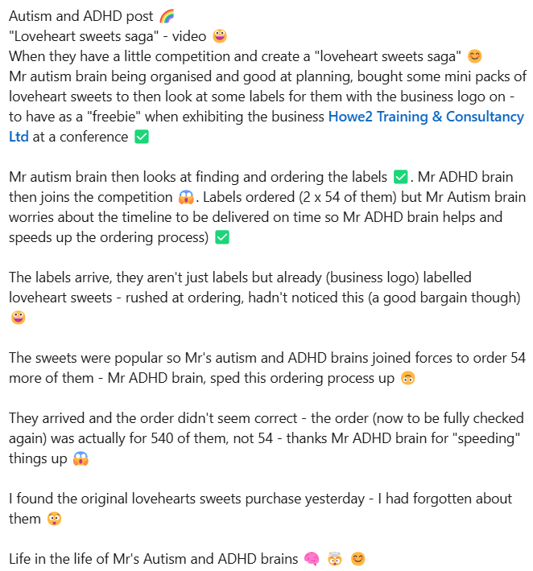Navigating the Overlap Between Autism and ADHD: Finding Balance Through Gardening
- infohowe2training
- Aug 29
- 4 min read
Autism and ADHD are two neurodevelopmental conditions that often occur together. This combination can lead to a unique mix of challenges and strengths for those affected. Understanding how these conditions interact is key to promoting mental well-being and personal growth. One effective way to navigate this overlap is through gardening, which can serve as a therapeutic outlet for individuals with these diagnoses.
Understanding Autism and ADHD
Autism Spectrum Disorder (ASD) primarily affects social interactions, communication, and behaviour. In contrast, Attention Deficit Hyperactivity Disorder (ADHD) is characterized by issues related to attention, hyperactivity, and impulsive actions. Although distinct, these conditions can share overlapping traits. For example, individuals with both may struggle to focus and may have heightened sensory sensitivities.
Consider Laura, a 10-year-old who has both autism and ADHD. Laura often finds herself engrossed in painting, staying focused for over two hours. However, she also experiences impulsive movements that make it difficult to navigate crowded spaces. Recognizing the interplay between these traits can help caregivers provide appropriate support.
Conflicts Between Autism and ADHD
When autism and ADHD coexist, the resulting behaviors can sometimes conflict. The impulsivity often seen in ADHD may disrupt the need for structure and predictability that individuals with autism crave. This can create feelings of frustration and anxiety, making daily life more challenging.
Jessica, a 12-year-old with both conditions, may set a routine for her homework, only to become sidetracked by a noisy environment, leading her to abandon her tasks. Additionally, the sensory sensitivities tied to both conditions can turn social events or loud settings into overwhelming experiences, heightening stress levels. Understanding these struggles is vital for caregivers aiming to create supportive environments.
Successes of Individuals with Autism and ADHD
Despite the challenges, many individuals with both autism and ADHD exhibit remarkable talents. The intense focus characteristic of autism can lead to outstanding skills in areas such as music, art, coding, or writing. When this focus is paired with the creativity often seen in ADHD, individuals can produce exceptional and unique work.
For example, Ethan, a high school student with both conditions, channels his hyper-focus into computer programming, creating an app that helps peers manage their homework schedules. Recognizing and nurturing these talents can boost self-esteem and foster a sense of accomplishment.
Clumsiness Linked to Hyper-Focus
Clumsiness is commonly associated with ADHD due to impulsive actions and challenges with coordination. However, when individuals with both conditions engage in activities that interest them, such as drawing or playing sports, they can find improved coordination as they hyper-focus.
Gardening is a perfect activity that merges these traits. The repetitive routines involved in gardening tasks can be calming and can help enhance focus and motor skills. For instance, when individuals plant seeds or water plants, they may find that their coordination improves, as they become absorbed in the activity.
The Therapeutic Benefits of Gardening
Gardening offers significant mental health benefits, especially for individuals with autism and ADHD. The act of nurturing plants encourages a sense of responsibility and accomplishment, both of which are vital for building self-esteem. Research indicates that spending time in nature can reduce anxiety by up to 70%, enhancing overall mood.
Sensory experiences are fundamental to gardening—feeling the texture of soil, smelling fragrant flowers, and enjoying vibrant colors can offer soothing benefits for those with sensory sensitivities. This connection to nature cultivates a safe space for self-expression and exploration.

Creating a Gardening Routine
Establishing a routine for gardening can significantly benefit individuals with autism and ADHD. Here are some practical tips to enhance the gardening experience:
Start Small: Opt for a few easy-to-care-for plants, which builds confidence without overwhelming the gardener.
Set a Schedule: Consistency is vital. Setting a regular time for gardening activities helps create a comforting routine.
Tailor the gardening experience according to personal interests. For example, if someone loves butterflies, planting flowers that attract them can foster a deeper connection and increase motivation. Using visual aids can also make the gardening tasks more understandable and manageable.
Finding Balance and Fulfillment
Navigating the overlap between autism and ADHD does present challenges but also offers unique opportunities for growth. By acknowledging the conflicts and strengths associated with both conditions, caregivers can create supportive environments that foster well-being.
Gardening emerges as a powerful tool for promoting mental health. It provides a therapeutic outlet that intertwines focus, creativity, and sensory engagement. By celebrating the unique traits of both autism and ADHD, individuals can create a balanced and fulfilling life.
Incorporating gardening into daily routines nurtures not just plants but also personal growth, resilience, and a stronger connection to the world around us.


Comments